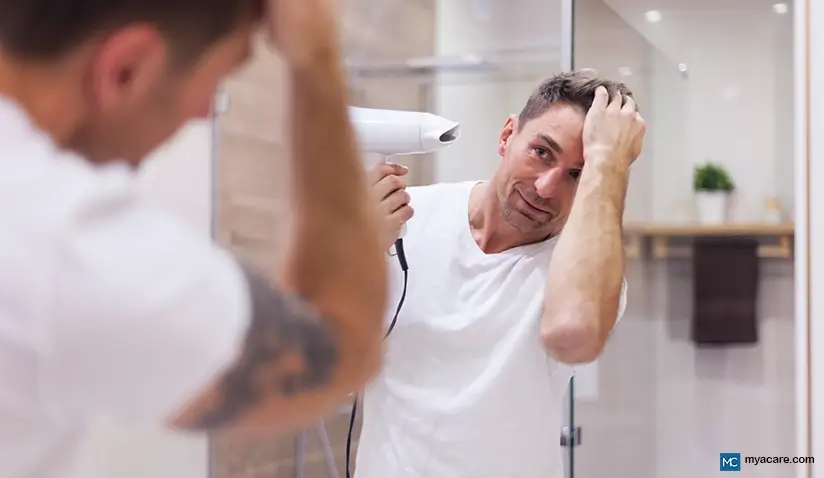PRP Therapy for Hair Growth – What Is It? Does It Work?

Nowadays, the most successful hair loss treatments focus on transferring live hair follicles to the areas of the scalp where the hair does not grow anymore. However, these procedures, such as hair transplants and Follicular Unit Extraction (FUE), do not treat the cause of baldness but only repair the aesthetic “damage.”
Despite all the effort over the years, scientists find it hard to bring dead hair follicles back to life. However, a recent approach to hair loss treatment using Platelet-Rich Plasma injections records some positive results.
In this article, we will discuss:
- Effectiveness,
- Safety, and
- Cost of PRP therapy for hair growth.
But first, let's explain what Platelet-Rich Plasma is.
Overview
PRP injections are a new option in the limited range of hair loss treatments. There are not too many studies about its effectiveness, but there are some promising results.
What is certain is that PRP therapy for hair growth is safe and possible to pair with other less invasive treatments. Also, the risk of complications is minimal.
A comprehensive treatment plan requires at least three consecutive sessions, with maintenance sessions to follow at least once a year. There are no immediately visible results. The progress is gradual and not the same in every patient. It depends on different factors, such as:
- Hair health,
- Blood platelet levels, and
- Overall health.
What is PRP?
PRP stands for Platelet Rich Plasma, blood-derived platelets highly concentrated in plasma solution. The goal of PRP is to boost the platelets' regenerative potential.
Platelet Rich Plasma contains a variety of proteins and growth factors. Together, these contribute to tissue repair and may reverse damage to hair follicles. PRP also has other medical uses. Namely, in healing injuries to ligaments, tendons, and muscles.
PRP is not a new thing in anti-aging medicine. It’s been around for some time, but the focus was on skin treatments. PRP injections help to improve the appearance and texture of the skin.
The use of PRP in hair loss treatment is a recent idea.
How is PRP made?
Platelet Rich Plasma is derived from the patient's blood. After drawing, the blood is centrifuged to separate the blood components. At the end of this process, there are three visible parts. The upper one is plasma, the small middle one is PRP, and the lower contains other blood components.
How is PRP treatment done?
After centrifuging the blood, doctors collect the PRP part with a syringe. Then, they inject it multiple times into the patient's scalp. The PRP treatment usually requires anesthesia. In most cases, the local and topical application will do. However, full sedation is sometimes necessary to eliminate pain and discomfort.
One session is not enough. A treatment package plan commonly involves three sessions, each one month apart. Additionally, maintenance sessions are necessary to maximize the treatment results. These usually take place every four to six months.
Effectiveness
There is still an ongoing debate in the scientific community about the effectiveness of PRP in hair loss treatment. There is no doubt, however, that platelets boost cell growth and regeneration. After all, they are one of the primary blood components, together with white blood cells, red blood cells, and plasma.
Platelets promote tissue rejuvenation even in standard concentrations. But, PRP contains four times as much. Therefore, its effects should be substantially stronger.
That takes us back to hair loss treatment. The idea is to inject PRP deep into hair follicles. Once there, the platelets may stimulate the proliferation of dermal papilla cells, which play a valuable role in hair growth.
So far, the research results show that certain types of hair loss respond better to PRP treatments than others. Androgenetic alopecia, as a leading cause of hair loss, is the most often studied type. The condition affects men and women, and it is hormone related.
In the case of androgenetic alopecia, PRP seems to work best in combination with other treatments, such as oral finasteride, dutasteride, and topical minoxidil.
More research is still necessary to determine the effectiveness of PRP in the treatment of other types of hair loss, such as:
- Alopecia areata,
- Telogen effluvium, and
- Scarring-related hair loss.
Safety, Side Effects, and Cost
In general, PRP injections are safe. That's, of course, if a qualified doctor with a thorough knowledge of scalp anatomy performs the treatment. Without anesthesia, the procedure is painful. So patients may experience some discomfort after each session.
Other side effects may include:
- Headaches,
- Redness,
- Swelling, and
- Temporary shedding of hair.
The scalp may also feel painful to touch.
The prices of PRP for hair growth treatment vary significantly around the world. In the United States, each session costs approximately one thousand dollars. In Thailand, for example, a complete package of three sessions costs around one thousand three hundred dollars, while in Turkey, a single session may cost as low as eighty to one hundred and twenty dollars.
Potential Complications
PRP injections are not a good option for people suffering from certain autoimmune diseases. Also, the use of anesthetics can cause an adverse reaction in some patients. For this reason, anyone with a history of adverse reactions to anesthesia should let their care provider know.
Since the PRP is made from the patient's blood, there are no complications that may arise from the injected substance. However, there is a minimal risk of:
- Infections (non-sterile needles or environment),
- Injury to nerve or blood vessels,
- Calcification at the injection points, and
- Scar tissue formation.
The Bottom Line
PRP injections are a novel approach to hair loss treatment. There is nothing miraculous about them, but the first results are encouraging. The procedure is simple and with a low risk of complications. However, it is not painless. Also, the cost is not low but affordable compared to some other more aggressive hair growth treatments.
To search for the best Plastic & Cosmetic Surgery healthcare providers in Croatia, Germany, Greece, India, Malaysia, Singapore, Slovakia, Spain, Thailand, Turkey, Ukraine, the UAE, the UK and the USA, please use the Mya Care search engine.
To search for the best doctors and healthcare providers worldwide, please use the Mya Care search engine.

Dr. Rosmy Barrios is an aesthetic medicine specialist with international work experience. She earned her physician diploma at the Universidad Del Norte’s School of Medicine in Barranquilla, Colombia, and her specialty at John F. Kennedy University in Buenos Aires, Argentina. Dr. Barrios is a member of the Pan-American Aesthetic Medicine Association (PASAM) and the Union Internationale de Médecine Esthétique (UIME). She is an expert health writer with keen interests in aesthetic medicine, regenerative aesthetics, anti-aging, fitness, and nutrition. Currently, Dr. Barrios heads the Regenerative Aesthetics department at a renowned Internal Medicine clinic based in Belgrade, Serbia.
References:
Featured Blogs



